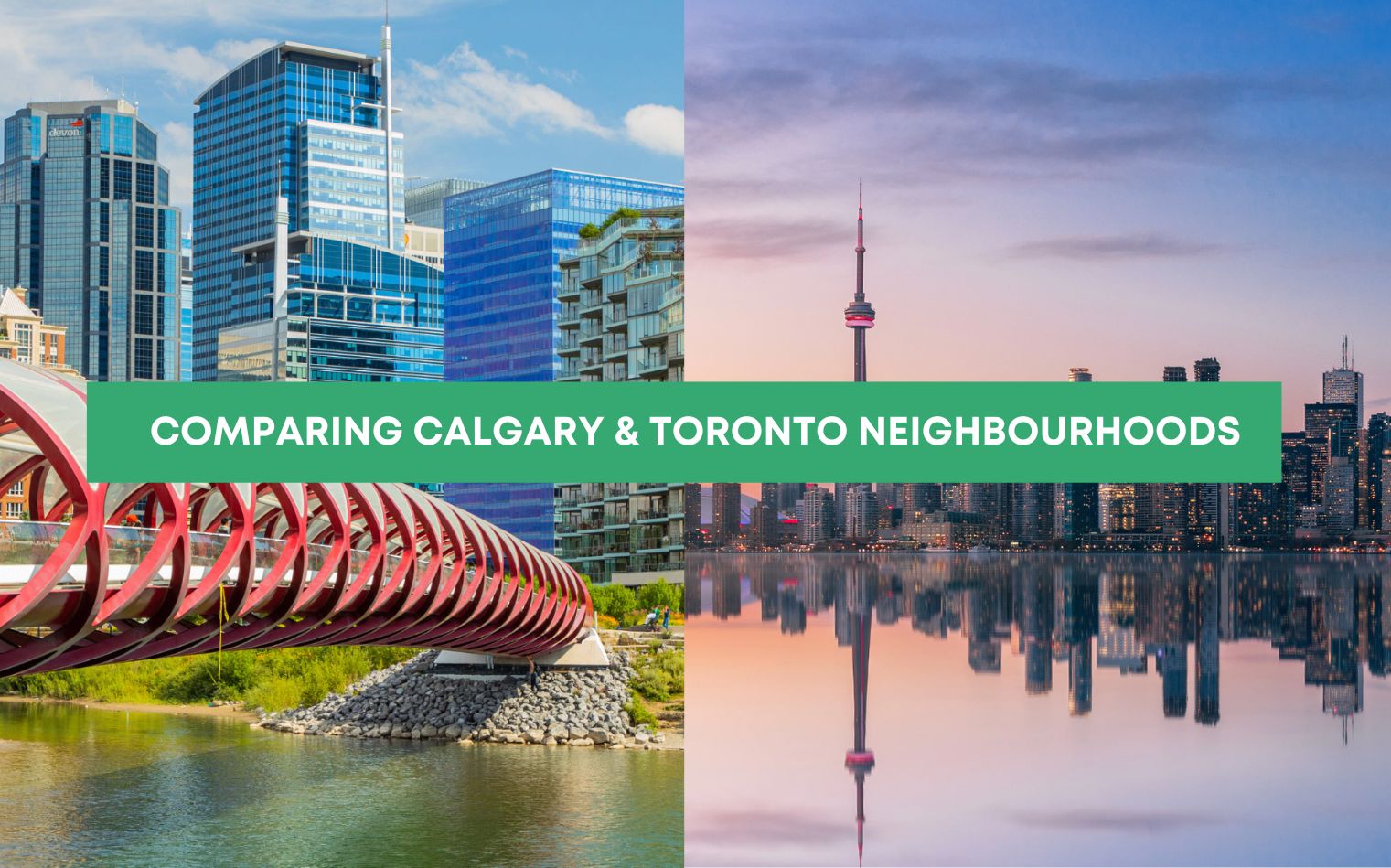Comparing Toronto and Calgary Neighborhoods: New Homes in Alberta
This article offers a concise guide for Toronto investors seeking to understand the diverse neighborhoods of Calgary. By drawing direct comparisons between familiar areas of the Greater Toronto Area and their counterparts in the City of Calgary, we aim to provide a clearer, more relatable perspective on Calgary’s residential landscape. This side-by-side analysis will help investors from Toronto navigate the real estate market in the City of Calgary with confidence, equipping them with insights into the cultural, lifestyle, and community parallels between the two Canadian cities. Whether it’s comparing bustling urban centers or peaceful suburban communities, this guide is an essential tool for those looking to invest in Calgary’s varied and dynamic neighborhoods.
Financial Hubs Compared: Toronto vs. Calgary
Toronto’s Financial District: The Heart of Canada’s Business
Toronto’s Financial District, in the heart of the Greater Toronto Area, is the bustling business core of the city, recognized for housing some of Canada’s top corporate headquarters, banks and firms. The district, one of Toronto’s best, is characterized by its steel and glass skyscrapers, which not only accommodate these business giants but also a variety of lunch spots and happy hour destinations. While predominantly catering to a 9 to 5 crowd, this city’s best area offers a unique shopping experience via the PATH, the world’s largest underground shopping mall. This network of pedestrian tunnels connects a myriad of buildings, hotels, subway stations, and retail outlets, catering to shoppers and professionals alike.
Boundaries of the Financial District are approximately defined by Queen Street, Front Street, Yonge Street, and University Avenue, offering easy access through key subway stations like King, Union, or St. Andrew.
Calgary’s Downtown Commercial Core: A Growing Business Hub
In contrast, Calgary’s Downtown Commercial Core, while smaller in population, is a dense urban district with the second largest concentration of head offices in Canada. This area in Calgary, Alberta, houses a mix of residential, commercial, corporate, and mixed-use neighborhoods. The diversity in building use speaks to a more integrated lifestyle, where work, home, and leisure more seamlessly intersect.
Downtown Calgary’s Commercial Core is enclosed by 14th Street W, the Bow and Elbow Rivers, and the CPR mainline tracks, creating a more compact area compared to the financial district of Toronto, also known as Greater Toronto’s business core. It includes distinct areas such as the Stephen Avenue Walk, known for its historic buildings, shopping malls, restaurants, cinemas, and nightlife, contributing to a vibrant street life. The Commercial Core is also home to several districts, including the Entertainment District and the Olympic Plaza and Cultural District, which adds to its multifaceted character.
Comparison in Living and Transportation
- Housing Costs and Affordability:Calgary’s housing is significantly more affordable. Renting in Calgary can be up to 40% cheaper than in Toronto. For example, a one-bedroom apartment in Calgary’s city center costs around $1,400, compared to $2,300 in Toronto.
- Cost of Living and Income: Calgary boasts a lower overall cost of living, despite Toronto offering a slightly higher average salary. The price per square foot for an apartment in Calgary’s city center is 54.1% cheaper than in Toronto.
- Public Transportation: Calgary’s public transportation is more affordable, with a monthly pass costing significantly less than in Toronto. Additionally, the Calgary Transit’s CTrain light rail system provides free rides through downtown on 7th Avenue S.
Population and Community Aspects
- Calgary’s downtown, as of the 2016 Census, had a population of about 38,663 people, with a significant proportion of residents being immigrants. A high percentage of housing in the area is used for renting, indicative of a mobile and diverse population.
In conclusion, Toronto’s Financial District caters primarily to business professionals with its corporate landscape and underground shopping complexes. Calgary’s Downtown Commercial Core, while also business-focused, provides a blend of residential and cultural experiences, emphasizing a more integrated urban lifestyle. The cost of living and housing in Calgary is notably lower, making it an attractive option for those seeking urban living at a more affordable rate.
Family-Friendly Suburbs: Toronto’s Leaside vs. Calgary’s Lake Bonavista
Leaside, Toronto: A High-Profile Family Hub
Leaside, located northeast of Downtown Toronto near Eglinton Avenue East and Bayview Avenue, is one of Toronto’s most popular and exclusive neighbourhoods. Historically developed as farmland and later incorporated as a town, Leaside is now part of the city of Toronto. It’s particularly sought after by upper-middle-class families due to its abundance of greenspace, parkland, and excellent schools. The neighbourhood is also renowned for its fine shopping districts, especially on Bayview Avenue, and offers excellent access to public transit. The area’s high real estate demand reflects its status as an ideal place for families to settle and raise children.
Leaside is characterized by a mix of single-family homes. It’s home to the Leaside Memorial Community Gardens, a large recreation centre with an indoor swimming pool, two ice rinks, a curling rink, and a large auditorium. Outdoor activities can be enjoyed in Serena Gundy Park and Trace Manes Park, which offer facilities for tennis, baseball, and ice skating.
Lake Bonavista, Calgary: Canada’s First Man-Made Lake Community
Conversely, Lake Bonavista in Southeast Calgary is notable as Canada’s first community built around a man-made lake, developed starting in 1967. It is bounded by Anderson Road, Macleod Trail, Canyon Meadows Drive, and Bow Bottom Trail. The area is known for its family-oriented environment and recreational opportunities, particularly with its proximity to Fish Creek Park, offering a variety of outdoor activities.
Lake Bonavista’s median household income in 2005 was $101,025, with a relatively low percentage of low-income residents. The community is served by the Lake Bonavista Promenade, which includes retail space and professional offices, providing convenient access to shopping along Macleod Trail and Southcentre Mall. The community also benefits from the Lake Bonavista Community Association, which manages a community centre with ice rinks, a gym, and multipurpose rooms. Additionally, Lake Bonavista has a second man-made lake, Lake Bonaventure, exclusively accessible to surrounding homeowners.
Comparative Analysis
- Family Orientation: Both Leaside and Lake Bonavista are highly desirable for families, with Leaside attracting upper-middle-income families in Toronto and Lake Bonavista known for its affluent community in Calgary.
- Recreational Facilities: Leaside offers extensive recreational options with its community gardens, parks, and sports facilities, paralleling Lake Bonavista’s emphasis on lake-based activities and community-managed recreational centers.
- Housing and Income: Leaside is marked by single-family homes and is known for being one of Toronto’s more expensive real estate districts. In contrast, Lake Bonavista’s housing is more affordable, reflected in the lower median household income.
- Greenspace and Outdoor Activities: Both neighbourhoods prioritize greenspace and outdoor activities. Leaside has parks like Serena Gundy Park for hiking and picnicking, while Lake Bonavista is adjacent to Fish Creek Park, offering a range of outdoor recreation.
In summary, while Leaside and Lake Bonavista differ in their urban contexts and specific amenities, they share a focus on family-friendly environments, abundant greenspace, and a strong community feel, making them ideal for family living.




